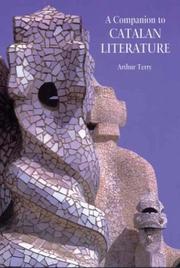| Listing 1 - 2 of 2 |
Sort by
|
Book
ISBN: 8490963029 8496820831 Year: 2020 Publisher: Madrid Casa de Velázquez
Abstract | Keywords | Export | Availability | Bookmark
 Loading...
Loading...Choose an application
- Reference Manager
- EndNote
- RefWorks (Direct export to RefWorks)
À la fin du xixe et au début du xxe siècle, les principaux conflits qui agitent la société espagnole se donnent en représentation sur les scènes des deux grandes capitales, Madrid et Barcelone. La rivalité économique et politique entre les deux villes se voit ainsi redoublée d’une compétition culturelle. En retraçant l’histoire de ces conflits symboliques, cet ouvrage offre un éclairage singulier sur l’Espagne de la Restauration. Émancipé de sa tutelle politique, le théâtre se libéralise et devient plus populaire, donnant voix aux aspirations démocratiques tout en s’ouvrant au marché culturel international. Tandis que s’opposent dans le reste de l’Europe les avant-gardes et l’industrie culturelle, la bipolarisation espagnole met cette tension en spectacle. A finales del siglo xix y comienzos del xx, los principales conflictos que inquietan a la sociedad española se representan en los teatros de las dos grandes capitales, Madrid y Barcelona. La rivalidad económica y política entre las dos ciudades se ve así redoblada por una competición cultural. Al volver a trazar la historia de estos conflictos simbólicos, esta obra ofrece un enfoque singular sobre la España de la Restauración.
Cultural studies --- Theater --- Restauration --- Barcelone --- zarzuela --- Madrid --- théatre --- opérette --- Renaixença

ISBN: 185566089X 185566206X 1800105312 Year: 2003 Volume: 193 Publisher: Woodbridge Tamesis
Abstract | Keywords | Export | Availability | Bookmark
 Loading...
Loading...Choose an application
- Reference Manager
- EndNote
- RefWorks (Direct export to RefWorks)
This book is the only one of its kind in English. Part literary history, part literary criticism, it is above all a personal assessment of a rich and important body of work which is still not widely known outside Catalonia. Catalan literature, one of the three major Peninsular literatures, reached an impressive level of excellence in the middle ages, beginning with Ramon Llull and the chronicles, and culminating in the two great fifteenth-century writers,the poet Ausiàs March and Joanot Martorell, the author of Tirant lo Blanc, one of the landmarks in early prose fiction. After three centuries of relative eclipse, the nineteenth-century Renaixença produced a distinctive version of Romanticism with notable achievements in poetry, theatre and the novel. More recently, Catalan writers have successfully assimilated a number of international tendencies, from Symbolism to Surrealism, while remaining deeply aware of the possibilities of the Catalan language itself. After the cultural disruption caused by the Civil War of 1936-39 and its aftermath, Catalan literature has once again shown its capacity for self-renewal, and the present literary scene is one of great interest and originality. The book does not presuppose any knowledge of Catalan; all quotations and book titles are translated, and a list of works translated into English is included.
849.9 --- Katalaanse literatuur --- 849.9 Katalaanse literatuur --- Catalan literature --- History and criticism --- History and criticism. --- Catalan identity. --- Catalan language. --- Catalan literature. --- Ramon Llull. --- Renaixença. --- Romanticism. --- Surrealism. --- Symbolism. --- cultural renewal. --- cultural shifts. --- literary history. --- medieval literature.
| Listing 1 - 2 of 2 |
Sort by
|

 Search
Search Feedback
Feedback About UniCat
About UniCat  Help
Help News
News